The last game of the FA Cup quarter-final was played between Newcastle United and Manchester City on a Sunday night. Maybe the City fans were not expecting a routine victory, as the Citizens failed to take all points at the St James’ Park previously. Thanks to goals from Kevin De Bruyne and Raheem Sterling, Pep Guardiola and his team progressed into the Semi-final of the competition.
The Manchester City manager has prepared a lot for this game, helping his team to dominate in all phases of the play. In this tactical analysis, we will dissect how the away team outplayed the opponents by some brilliant tactics.
Lineups
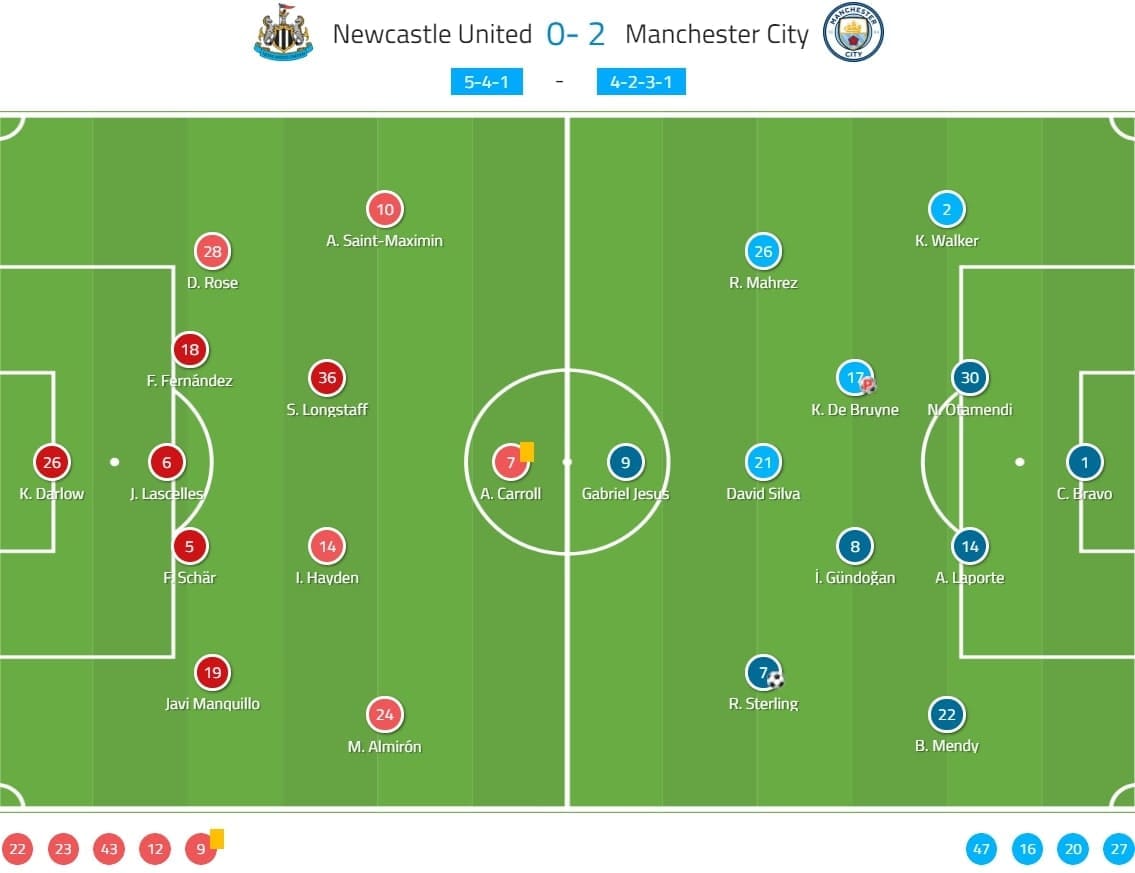
Despite playing in a 5-4-1, some regular starters in the league were missing in this lineup, including Joelinton, Jonjo Shelvey and Jetro Willems. Andy Carroll, Sean Longstaff and Danny Rose took their position. Also, it was Javi Manquillo to play as the right wing-back instead of DeAndre Yedlin.
City started a very strong squad. Nicolás Otamendi partnered with Aymeric Laporte as the centre of the defence. The Brazilian striker Gabriel Jesus led the line. Intriguingly, this 4-2-3-1 shape with De Bruyne dropping alongside İlkay Gündoğan was the key to success.
Newcastle’s defensive scheme
As usual, Bruce’s team were defending with a 5-4-1 defensive block, prioritizing on maintaining the defensive shape instead of committing players to press. The intention was very clear: sit deep and deny City’s progression into the penalty box, waiting for the counter-attacking opportunities.
They allowed City to receive and progress into the central third. In this example, when Otamendi passed to De Bruyne, S. Longstaff retained his position instead of pressing the Belgian international.
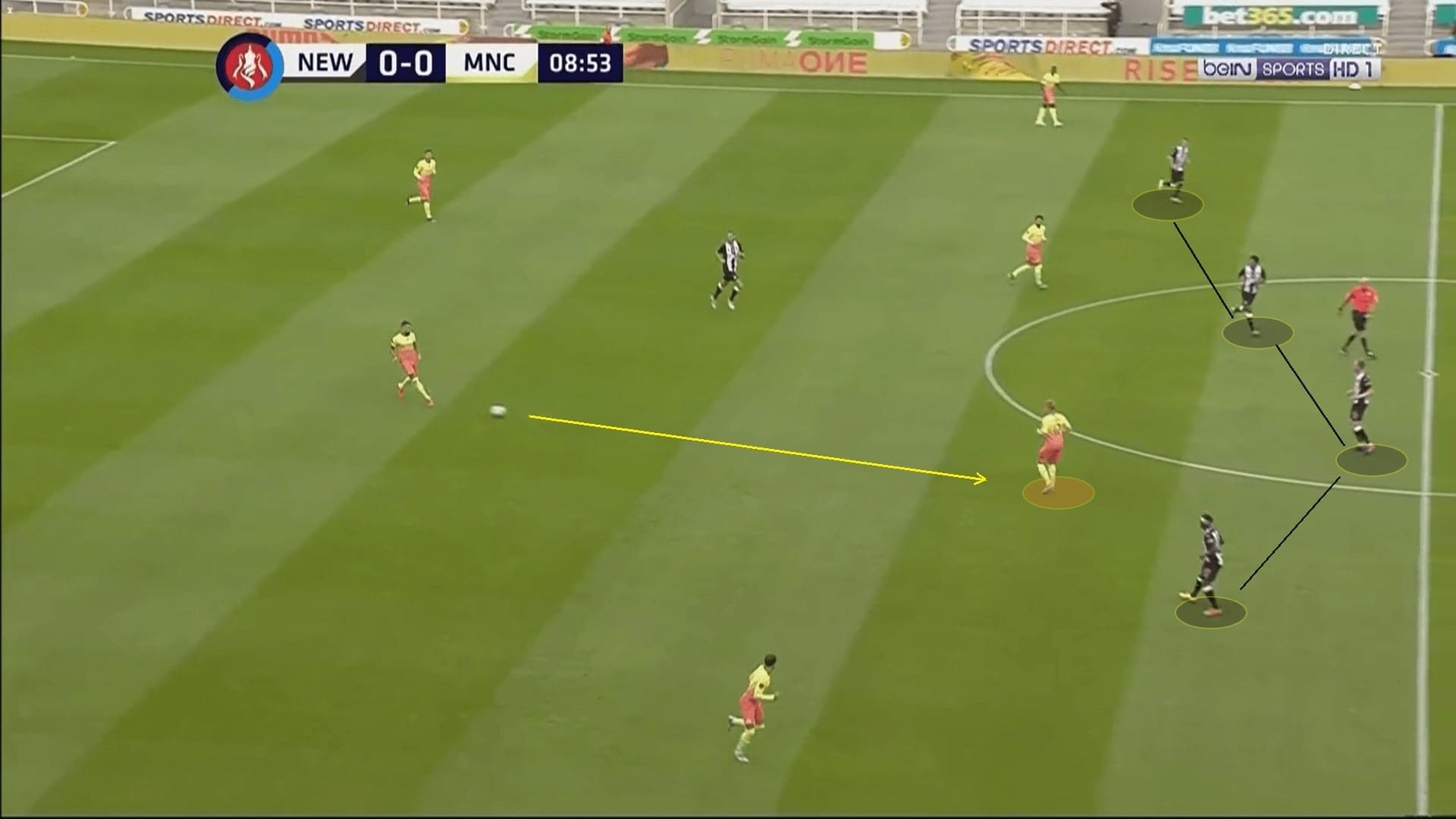
When defending in their own half, Newcastle always tried to force the ball wide by shutting the central passing lanes. Maintaining the second line compact was the main strategy to shadow players between the lines. When a City midfielder (Gündoğan or De Bruyne) was holding the ball at the centre, either Newcastle central midfielder in the corresponding vertical zones should apply pressure to prevent the through balls.
Meanwhile, Carroll only had very light defensive duties in the first half, as Bruce wanted the Englishman forward to stay high and serve as the target man. This was expected to be useful in creating some counter-attacking opportunities in the offensive transitions.
Below, Isaac Hayden pressured Gündoğan and forced a back pass. The second line covered the ball side by the close proximity of players, and David Silva was behind the shadow. Therefore, Laporte switches the ball to the other vertical half as no good progressive option at this side.
Another player with a lighter defensive responsibility was Allan Saint-Maximin. The Frenchman winger was quick and the skilful dribbler who could initiate the counter-attacks. Therefore, Bruce allowed Saint-Maximin some freedom to distance himself with Longstaff, which should generate more spaces in the offensive transitions initially.
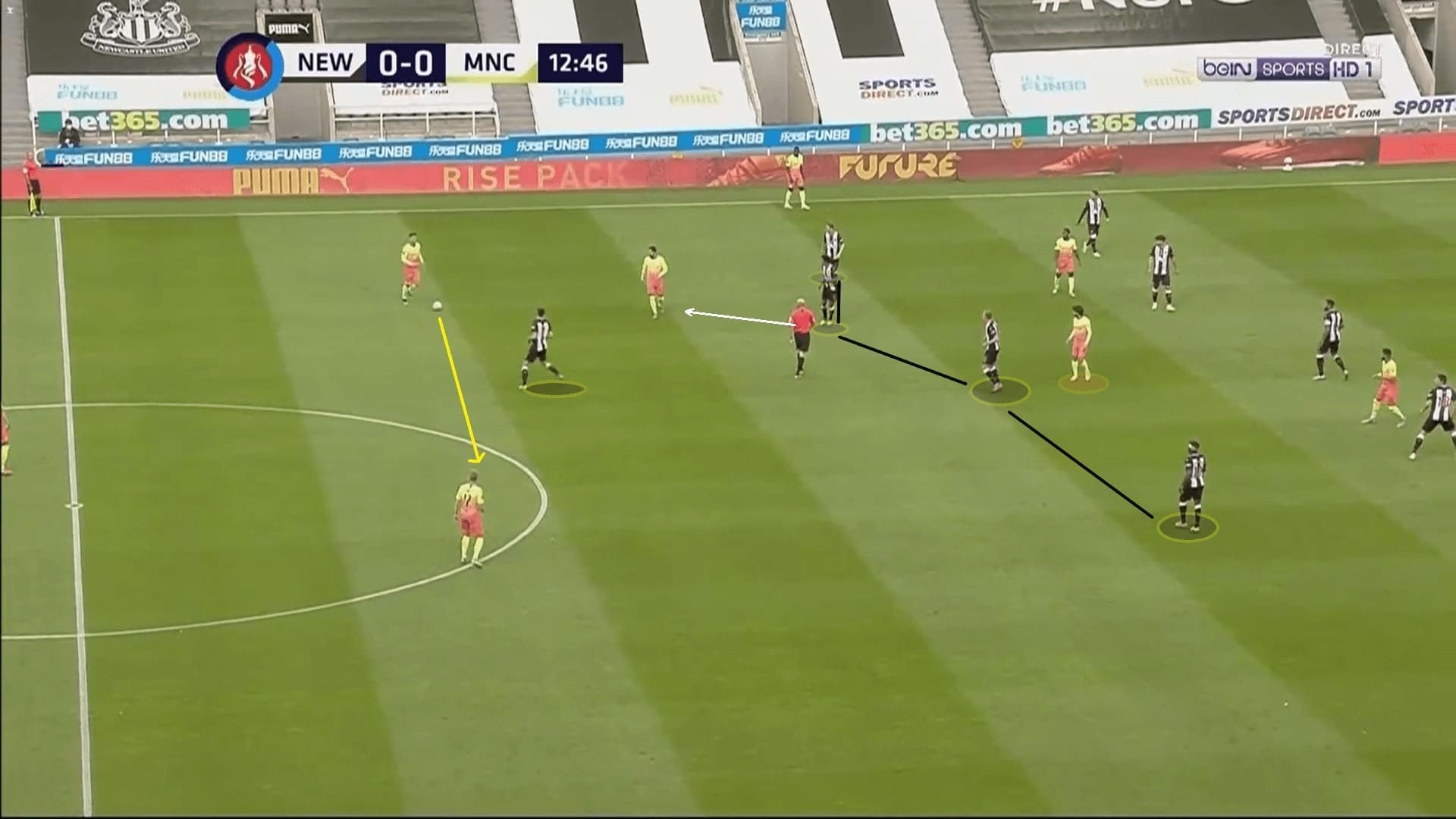
Newcastle wished City to play the ball at flanks as defending out wide was their strength. The Magpies were committing the vast majorities of players to the ball side and compress spaces around, suffocating any passes within the defensive block.
Newcastle executed this tactic quite well and the shape was incredibly compact. The first was to commit the wing-back, who was Manquillo below to pressure the wide receiver. Meanwhile, the winger should shut the central passing lane, shifting with the rest of the second line. Here, the passing lane to D. Silva was shut quickly, unless the in-ball was played with the first-touch, or else Miguel Almirón would be there.
As we have drawn, the block was extremely compact horizontally and vertically. Although City attempted to play into the tight area, the passes were never smooth because of the instant pressure around the ball.
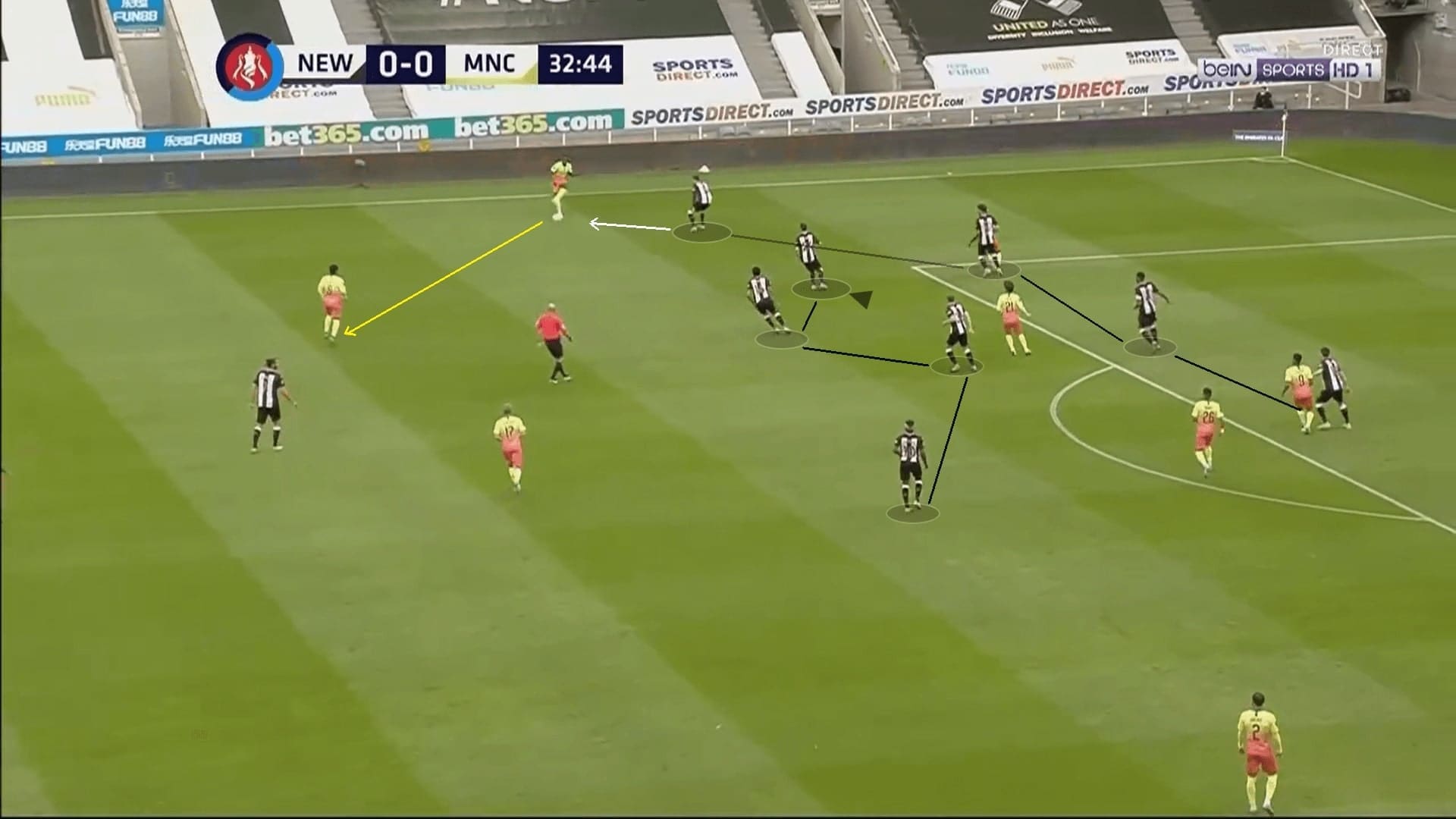
On the right flank, the contexts were different as D. Silva was the only man between the lines. Saint-Maximin did not have to shut the central passing lane like Almirón above.
The numerical advantage was guaranteed. In the above scenario, seven to eight Magpies were on the ball side. And, even the ball was switched to the weak side, Newcastle still had a 3 v 2 numerical superiority at least. This was an advantage of the back five, when the wing-back left his position, the wide centre-back always provided the defensive cover.
In this case, Riyad Mahrez was contained within the Newcastle block. In other words, City could only rely on Kyle Walker if they wished to reach the byline.
Newcastle were also well-prepared to defend the crosses by committing at least three players in front of the six-yard box. Cramming many defenders in such a tight area was conducive to block the shots and they denied a good chance of Jesus by this.
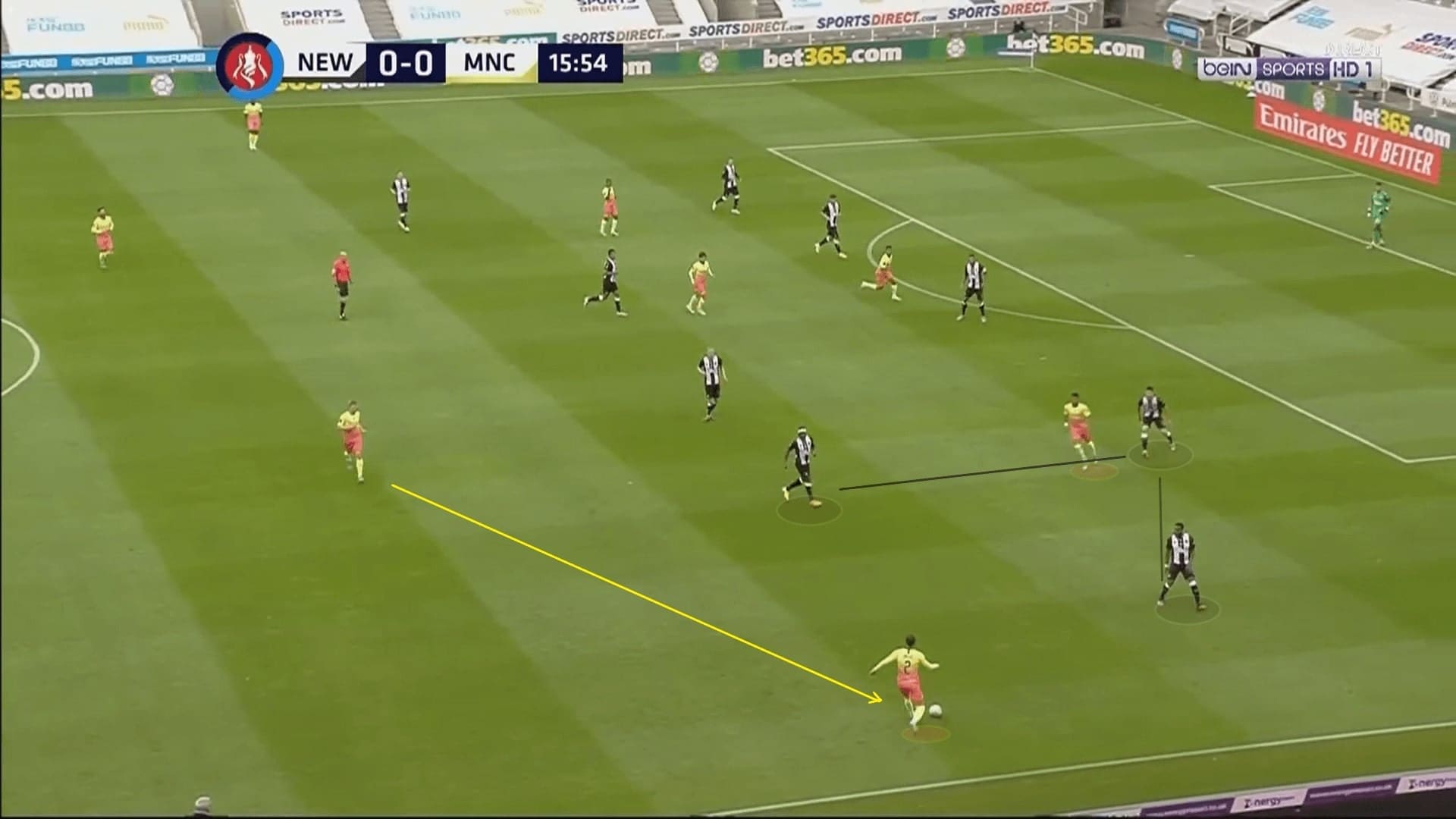
However, this conservative approach might affect the mindset of the players slightly. Even when applying pressure, the Magpies were not trying to force into duels and tended to protect the zone.
There were several occasions that Rose was too far away from Walker, allowing the former Tottenham right-back to cross. Although Newcastle did not have to go aggressive, they should try narrowing the ball-playing angle by the body orientation.
This detail has led to the first conceded goal. We knew Jesus was fouled and a penalty was awarded. What we were pointing out was the defensive action of Rose here, who left Walker to play a beautiful spinning cross.
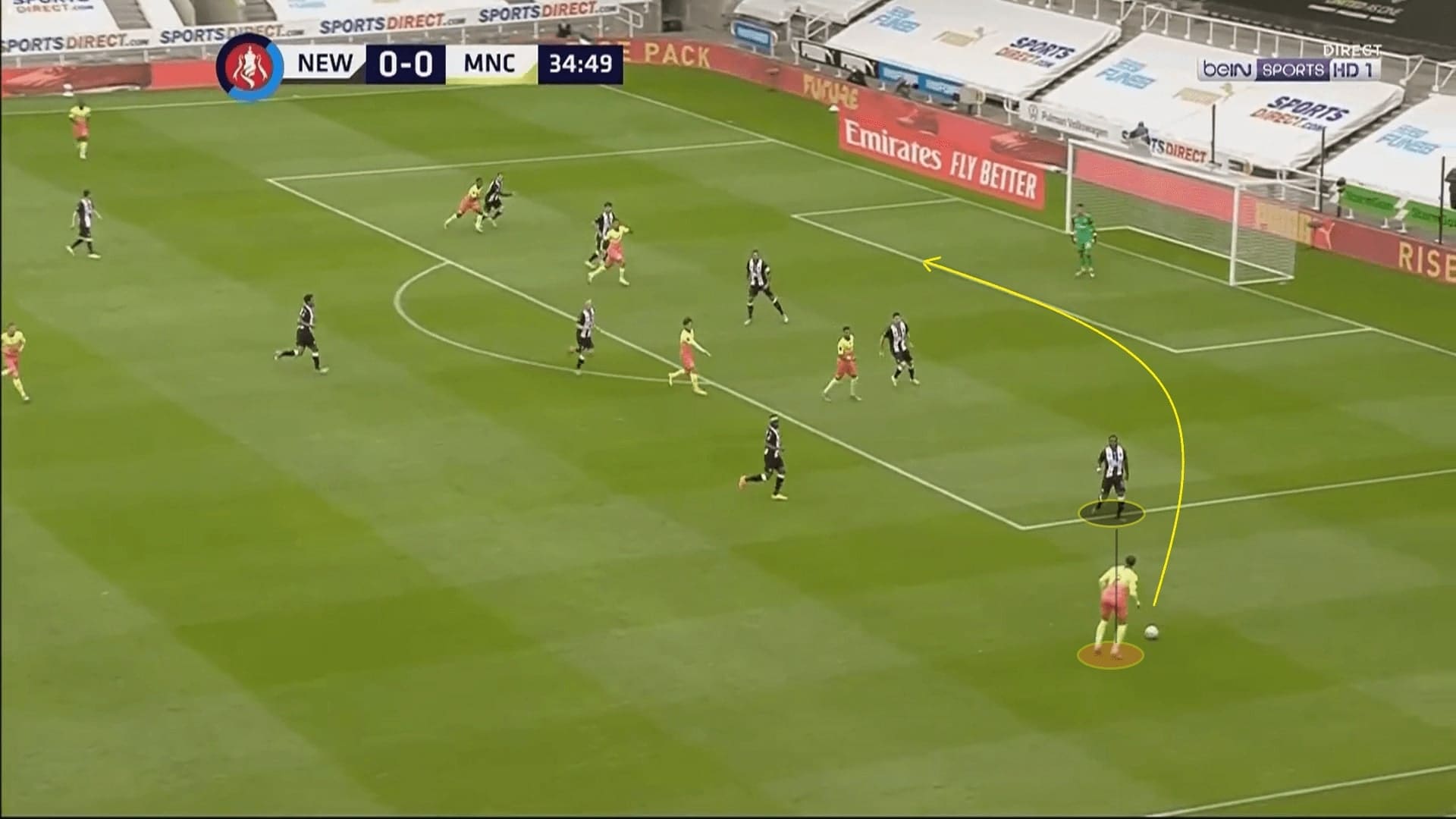
Central overload and domination
Breaking a low block was not a new task for Guardiola’s City. In the recent Burnley game, it was more emphasizing on maximizing the qualitative superiorities at flanks, which City adopted different approaches. At the St James’ Park, it was more about generating passing options through the central overload.
Since we explained how the Magpies allowed City to enter the central third, the build-up phase was simpler, and we were not explaining the niche 2 v 1 overload on the striker. Instead, the key was the deep positionings of De Bruyne, which Bruce might not saw that coming.
In this game, City were playing De Bruyne with Gündoğan at the second line, inverting the winger and D. Silva to exploit spaces between the lines. The narrow positions of Sterling and Mahrez perfectly avoided D. Silva being covered and isolated, and, they were the additional passing options at the half-spaces. If focusing on the numerical superiority, this could be interpreted as a 5 v 4 at the centre.
Here, with Mahrez was one of the interiores, and he offered De Bruyne a progressive passing option behind the midfield. Including Gündoğan and D. Silva, the Belgian international had three options.
Credits should be given to Jesus as well, who slightly adjusted his style of play. The role of the Brazilian striker was to stay with the last line and providing the offensive height, not serving as the “false-9”. This manipulated the behaviours of Magpies central defenders and further boosted the positional superiorities of players between the lines.
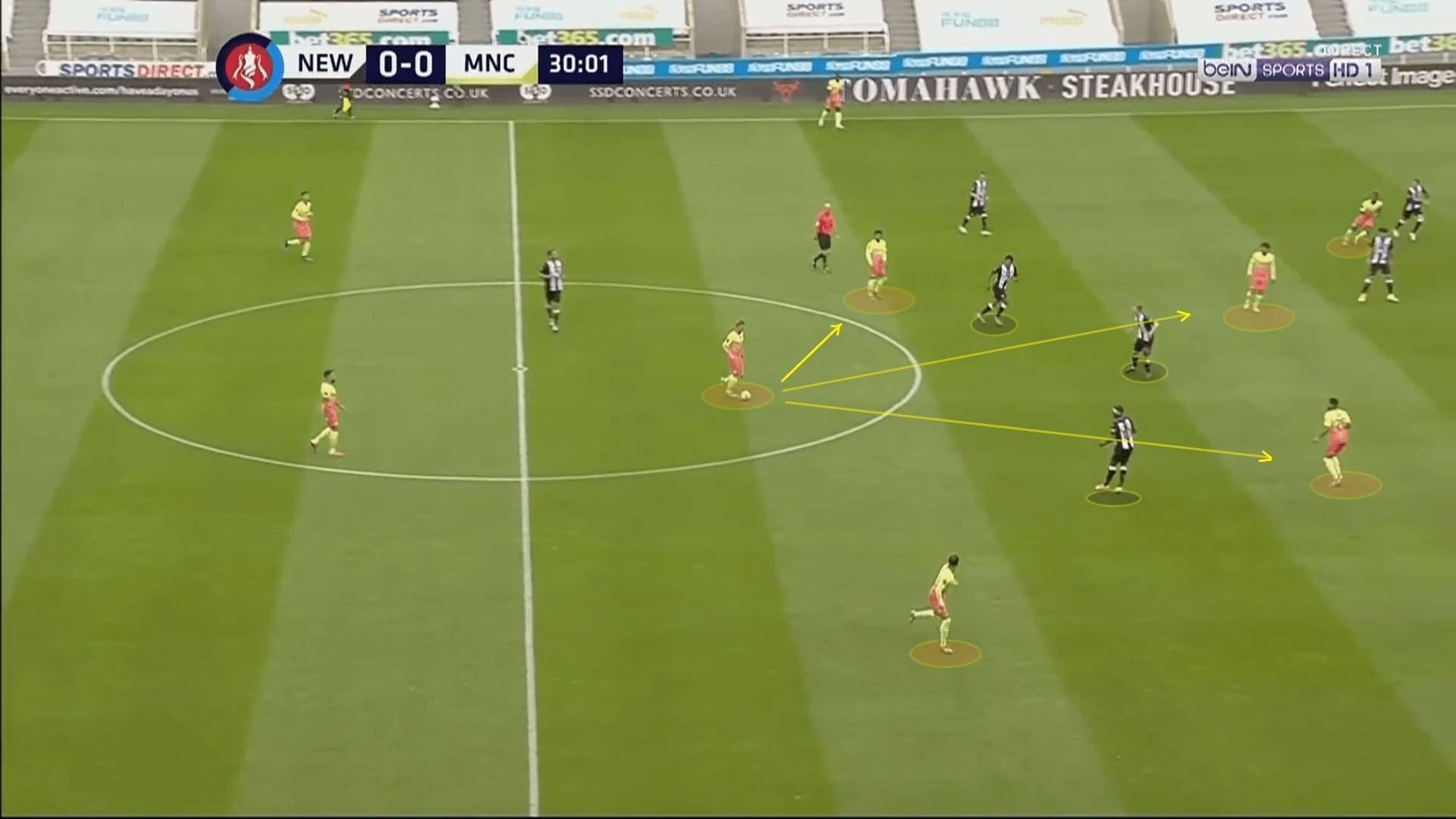
In this game, City attacked flanks with the full-backs. Above, Walker tried to stretch Sanit-Maximin from the defence by providing the width. This might be suboptimal as Mendy and Walker’s qualitative superiorities were not as good as the wingers. Guardiola understood this as well, thus, City seldom passed to the wide areas early as this would fall into the Newcastle as explained.
What City did well was keep troubling the defensive block, utilizing the irregular positionings of Sterling and Mahrez as the progressive options. Here, Sterling cleverly placed himself out of the block as the second line were narrow at the centre. This opened the passing lane and City could continue to attack at the half-spaces.
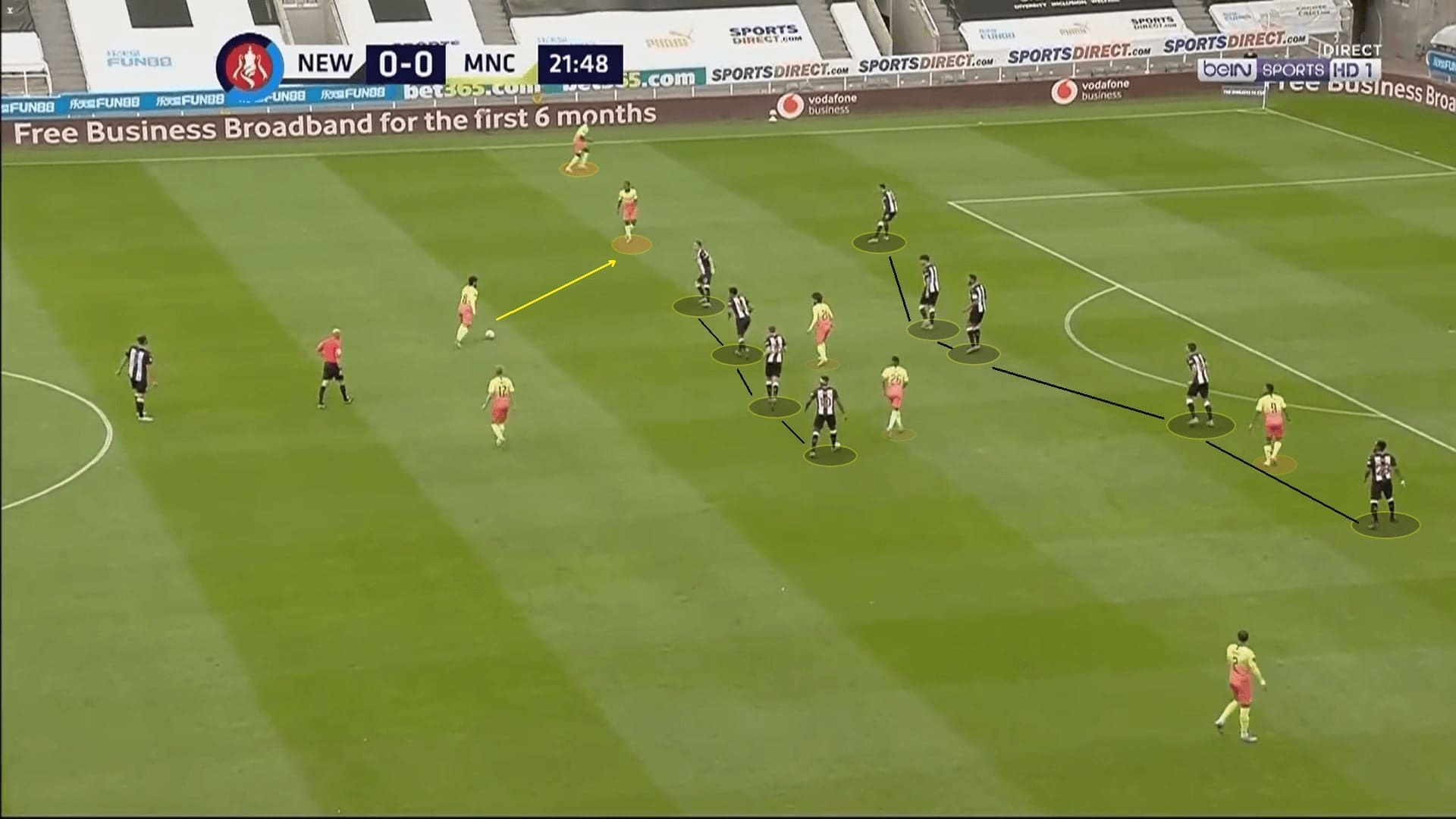
Gündoğan was playing aggressive in this game, playing good passes to penetrate into the block. The German international was clever, always doing something purposefully. By dribbling forward patiently, Gündoğan always drew a player out and passed to spaces behind.
Here, Gündoğan took Longstaff out of position and angled himself for a pass to D. Silva, who was between the lines.
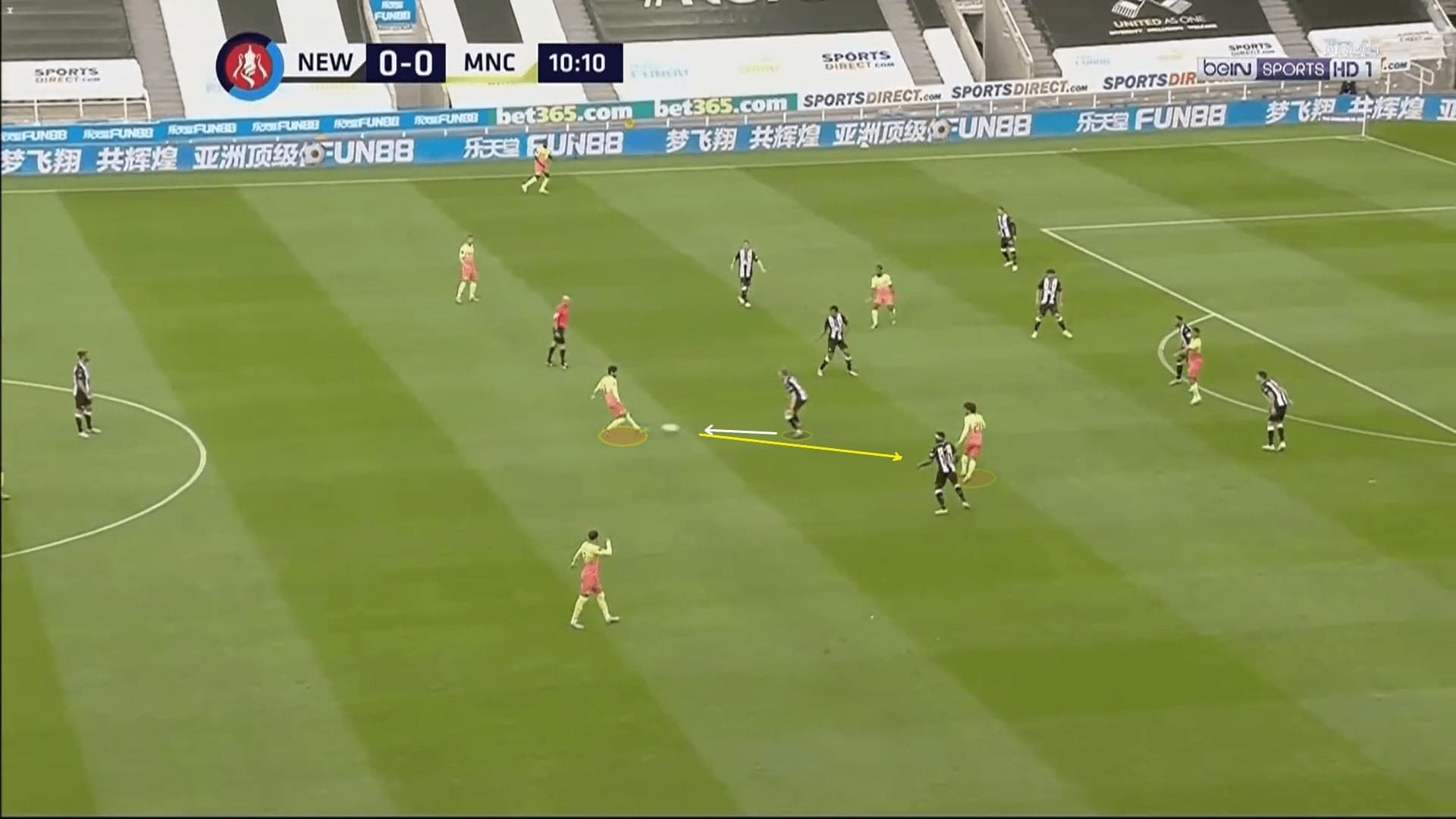
Transition phases
Apart from the offensive tactics in the above analysis, what helped City to dictate the game was their good performance in the transition phases. In the offensive transitions, mostly cases after winning the second balls, De Bruyne maximized the benefits of the deep runs and received the ball behind the second line.
Here, the Magpies were disorganized defensively and Saint-Maximin was yet to recover his ground. De Bruyne timed his run from the Frenchman winger’s blindside and found by a lovely pass from Gündoğan.
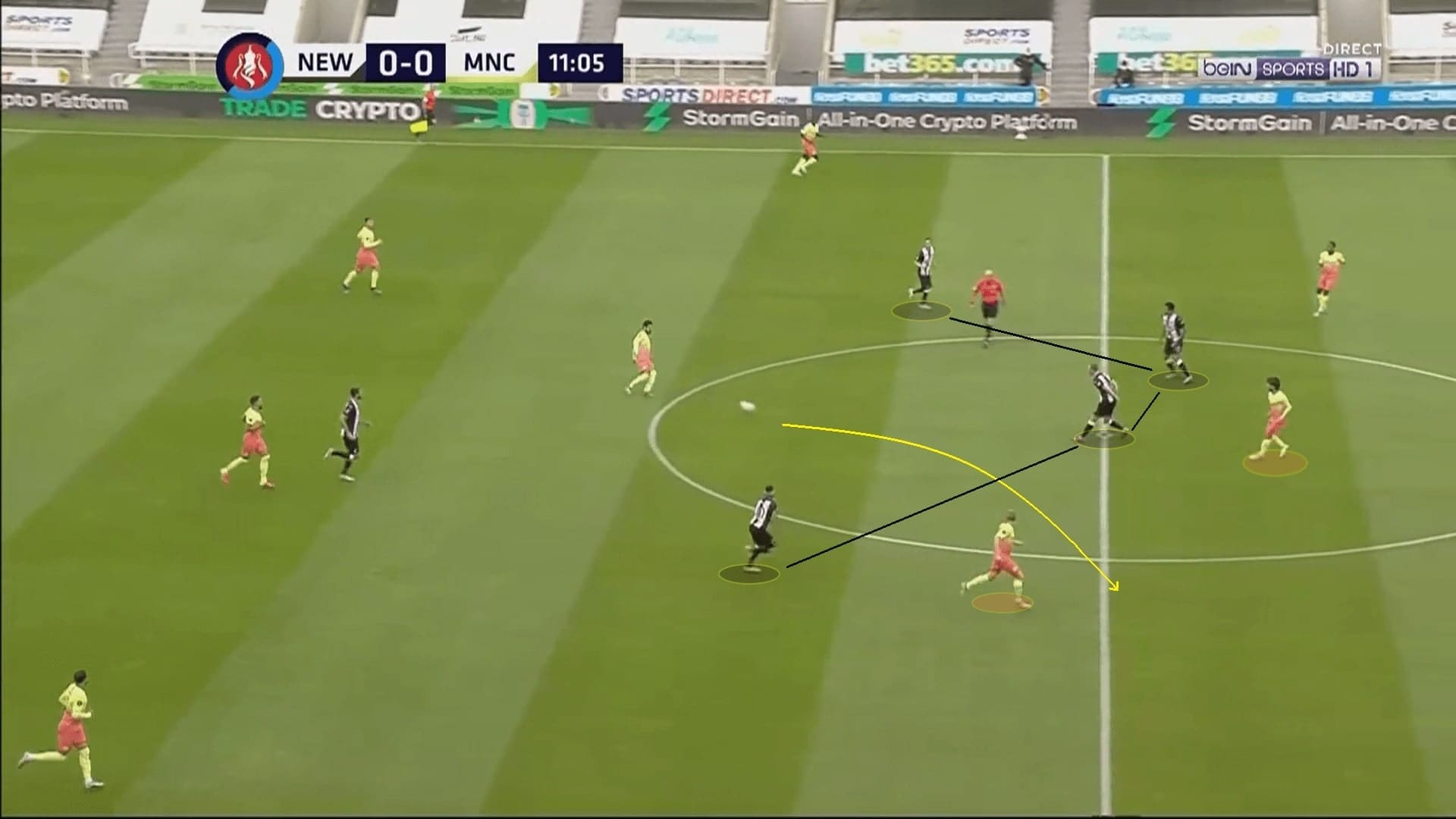
The deep positioning of De Bruyne also offered the solidity in the defensive transitions. Guardiola should have identified two key players in the Newcastle counter-attacks, one of them was Saint-Maximin.
Merely leaving Gündoğan as the sole pivot, pushing Walker and Mendy high was too dangerous. Playing De Bruyne with the German international formed a two-man layer in front of the centre-backs, keeping the counter-attacking options under control.
Here, Newcastle regained possession in the penalty box, City were counter-pressing as usual. Hypothetically, it was impossible for Gündoğan to defend Almirón and Saint-Maximin alone. With De Bruyne, it was a 2 v 2 which allowed City to suffocate the counter-attacking opportunities better.
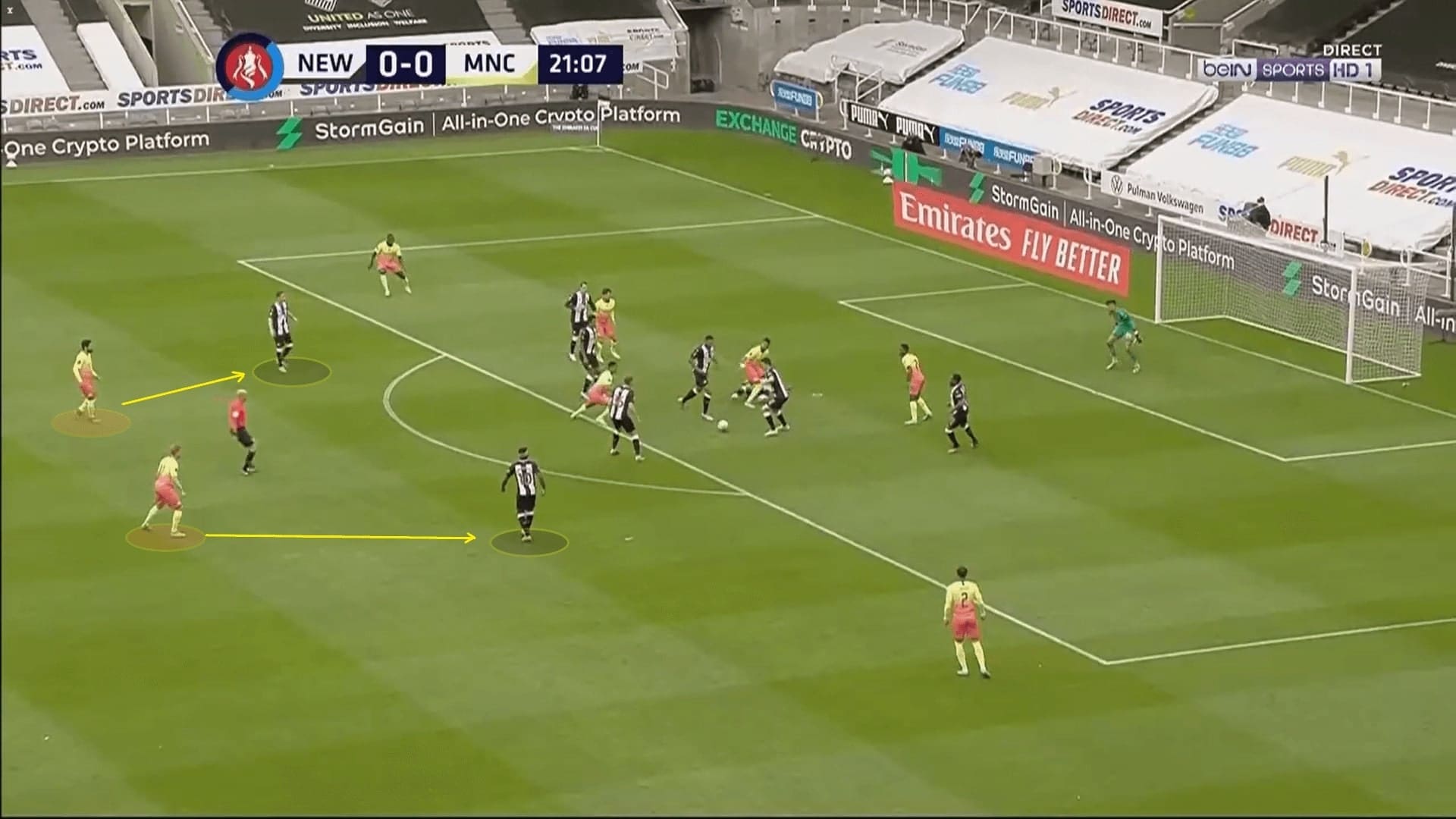
Thanks to the above approach, City centre-backs stayed around Carroll to ensure the 2 v 1 situation was created. The former Liverpool striker was extremely strong in the air, possessing the physical superiorities and it would be risky to mark him with one defender only.
Since Otamendi and Laporte were there, the defence was solid in the defensive transitions as Carroll could not hold up plays. This helped City to dominate the game and restart the attacks one after one.
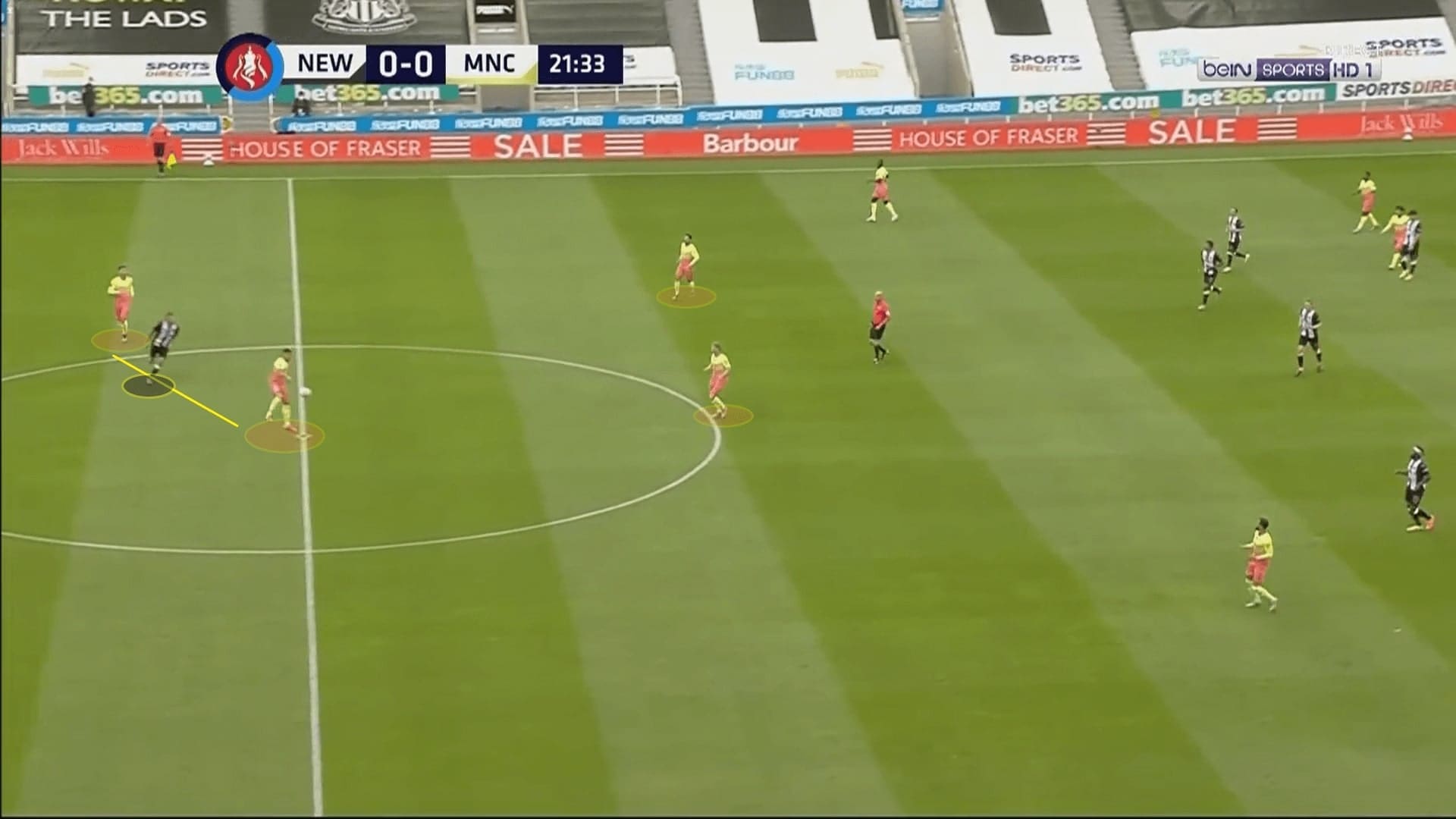
A different second half
One-goal down in the first half, Bruce’s team needed a goal in this cup tie. In the second half, Newcastle were more aggressive in the defensive phase. This was suggested by the PPDA, which averaged in 23.79.
Below is the PPDA graph of Newcastle, the contrast was sharp in the first and second 45. In the first half, the index ranged from 37 to 57 while this dropped significantly, which was 7.5 to 26.7 in the second half.
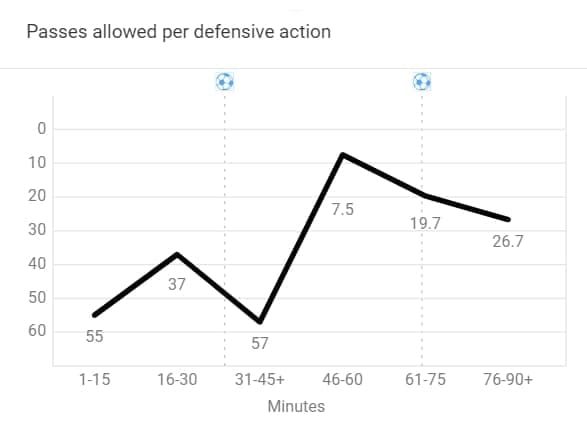
Bruce switched his team from a 5-4-1 into a 4-1-4-1 in the second half, added an extra man in the midfield to match the City trio. This allowed the Magpies to go man-to-man on D. Silva. De Bruyne and Gündoğan, potentially to force some errors because of the pressure.
City responded (or even anticipated) cleverly by inverting Walker to the second line, freeing De Bruyne behind the midfield. Corresponding to the right-back, Mahrez stayed wide to provide the width.
Also, pressing the opponents also suggested the loose defensive shape of the Magpies, especially losing compactness vertically. Guardiola’s men were clever to exploit these spaces to progress plays.
Here, Gündoğan played a diagonal forward pass to find Sterling, who was between the lines. The passing lane was wide because of the Newcastle press.
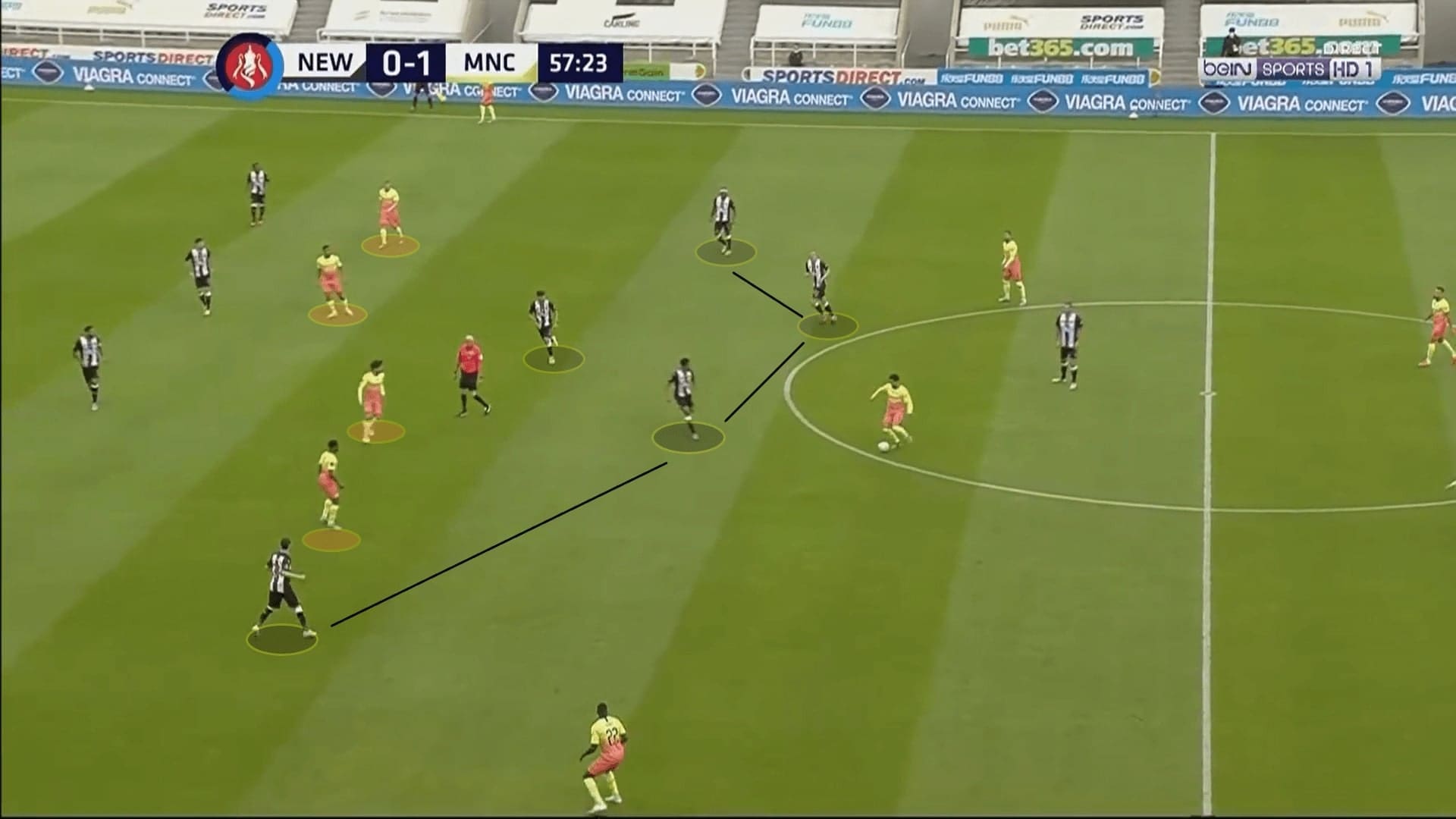
The man-marking in the midfield caught City once, as Otamendi misplaced a pass in the own third. Dwight Gayle got an 0.44 xG opportunity but it was wasted.
Here, the 4-1-4-1 shape allowed Newcastle pushed high to mark City midfielders in three 1 v 1 situations, and recovered the ball in the final third. However, the Magpies were not strong at pressing and the success depended on the opponents more than their own. City were careful after this mistake and dominated the ball until the final whistle.
City exploited a huge flaw of this defensive shape and scored the second goal. Many people were praising the delicious long pass of Laporte, but a prerequisite to making this happen was the vertical distances between players. We have drawn below, and the scene before the goal was just repetition.
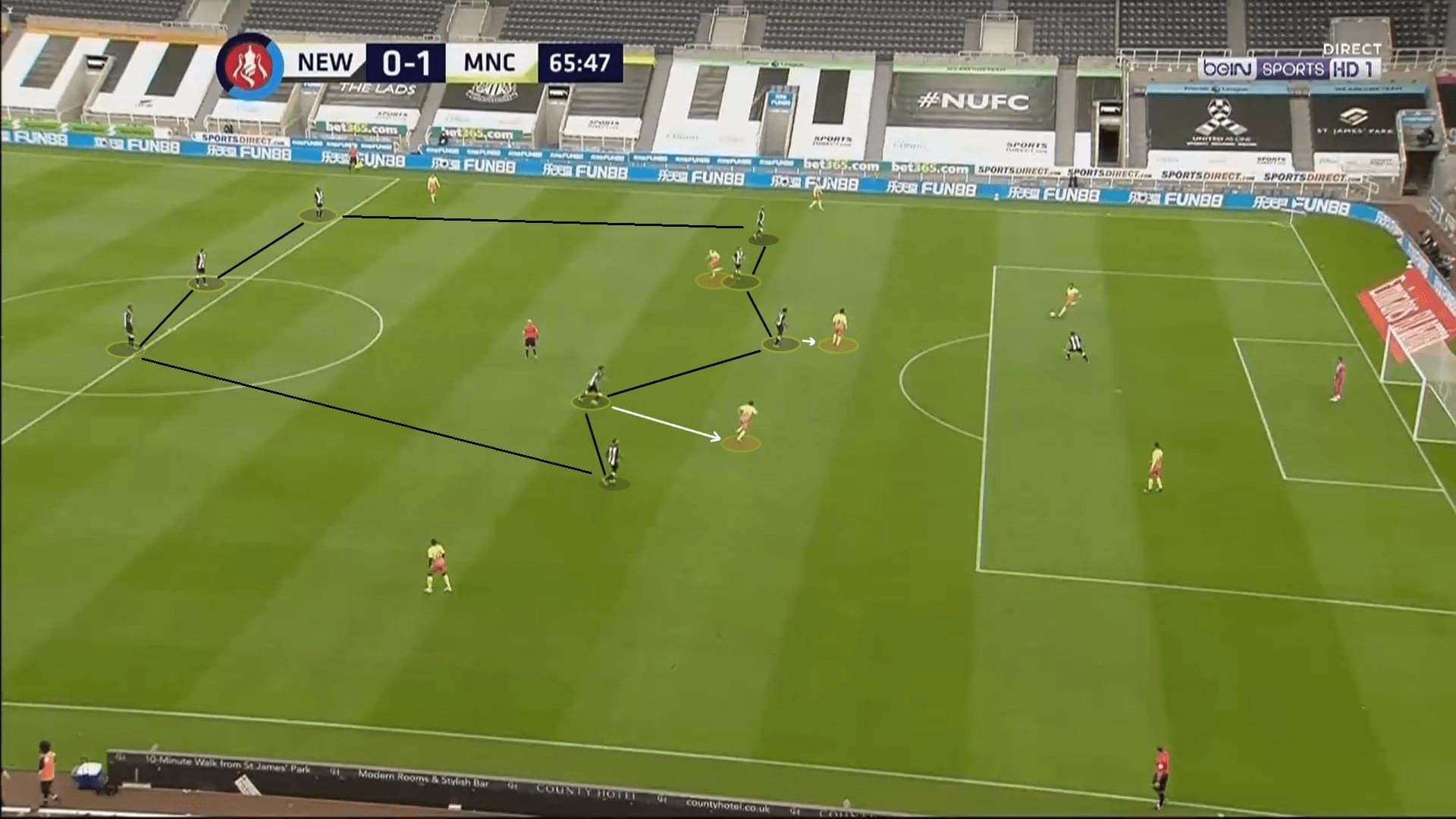
Final remarks
City were playing quite well, although the more goals should appear, some chances were wasted. Guardiola’s insight of a game was exceptional, the tweak on the role of De Bruyne was vital to qualify into the next round. Their next FA Cup game against Arsenal will be a very interesting one!





Comments